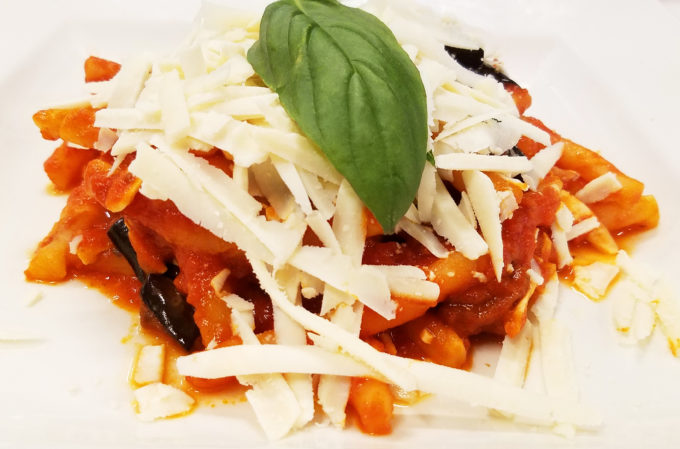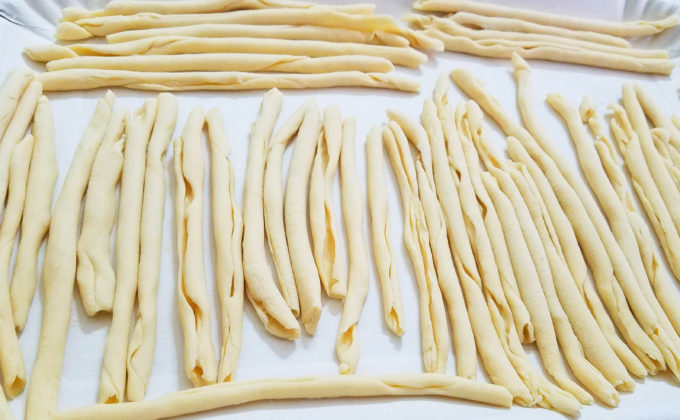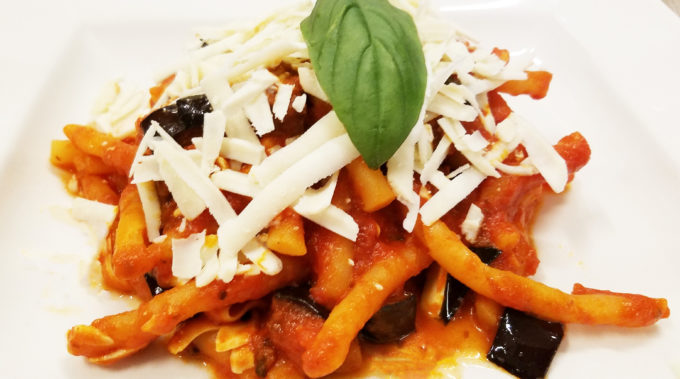If you’ve been to Sicily, you must have noticed pasta alla Norma popping up on many menus. From Michelin star restaurants to family gatherings, the eggplant pasta tends to grace the dinner table at least once during your stay in Italy. Through the years, food enthusiasts have debated over the best recipe for this classic pasta dish. Some cooks stick to the traditional fried eggplant version, while others have gotten creative and opted for roasted/sautéed veggies. Despite the differences in opinions, everyone agrees on keeping three core ingredients; eggplant, ricotta, and basil. Before diving into the recipe, let’s learn the history of this popular Sicilian dish.
Origins of Norma Sauce
What’s the Back-story of Pasta alla Norma? People who don’t speak Italian might assume that ‘norma’ refers to the hero ingredient—eggplant. You’d be surprised to know that ‘Norma’ isn’t the name of any vegetable. It is the name of a woman. A fictional character, to be precise!
As the story goes, the history of pasta alla Norma has been traced to Catania. A coastal city located on the eastern side of Sicily. In the early 1800s’ the town was infamous for its opera because of the talented Vincenzo Bellini. The world-famous Italian opera composer has produced several successful plays. Norma is a nod to one of his favorite masterpieces. The vegetarian dish shares its name with the female lead in the play.
How did an Opera Lead to Eggplant Pasta?
After watching his play, Bellini’s friends began comparing everything great with their friend’s play. The epithet became popular around town as everyone attributed Norma with impressive places, food, art exhibitions, etc.
One day, playwright Nino Martogolio christened a pasta dish after Norma. It’s said that he exclaimed, “Chista è ‘na vera Norma!” (“This is a true Norma!”) as soon as he had his first bite of the eggplant pasta.
Eventually, the compliment became the real name of this delicious eggplant dish as it captured the essence of its unique flavors and taste.
How to Make Fusilli alla Norma?
In this recipe, I like to use a typical handmade pasta often found in southern Italy. It is called fusilli and in some dialects, it is known as fileja. This is not the short “corkscrew” pasta shapes or the long curly pasta shapes we identify as fusilli Basically, these fusilli are made by rolling a piece of dough around a metal or wooden rod to get a thin long twisted shape.
You can see the video below to see how it is typically done. This is also a fun family thing to do because the more hands the more fusilli you can make and the sooner you can enjoy the fruits of your labor. Of course, you can skip making the pasta by hand and buy your favorite type of fusilli, and then all you’ll need to do is make a delectable Norma sauce.
I stick to a Norma sauce with fried eggplant, tomato sauce, fresh oregano, fresh basil, and ricotta salata. If these ingredients are at their best there is no reason to reinvent the wheel.
Pasta alla Norma
(serves 4 people)
Norma Sauce Ingredients
- 1 eggplant, medium size
- 1/2 cup Extra Virgin Olive Oil, or as needed
- Salt and pepper for seasoning
- 1 tbsp chopped garlic garlic
- 2-3 chilis, sliced thin (optional)
- 10 Roma tomatoes or one 28 oz. can of your favorite canned tomatoes
- 1 lb. (500g) penne pasta
- 1 teaspoon fresh oregano
- basil leaves, to garnish
- 1/2 cup ricotta salata, grated to garnish
Fusilli pasta ingredients
- 1 ½ cups (213 grams) All-Purpose Flour (unbleached)
- 1 ½ cups (250 grams) fine semolina
- 1 cup – room temperature water, more or less depending on the flour and humidity
Make the Fusilli
- Mix the flour and semolina together in a bowl to combine.
- Create a well in the center of the flour and mix in ¾ cup of water until well incorporated. Gradually add the rest of the water, little by little, if needed. The dough will be firm.
- Knead the dough on your work surface (5-10 min) until smooth and pliable.
- Cover and let rest at room temperature for 30 minutes. (Or refrigerate until ready to use. Let stand at room temperature for about 30 minutes.)
- Once the dough has rested, knead again for a few minutes to make it pliable.
- Pinch off a marble-sized amount of dough and roll it out to the size of a small rope.
- Roll each piece around a metal skewer or knitting needle, stretching it outward with the palms of your hands as you roll to form the Fileja shape
- Carefully remove the pasta by twisting the needle while gently holding the pasta.
- Place on a tray to slightly dry for about 30 minutes.
Once your pasta is made you can then work on the Norma sauce.
Prepare the Eggplant
- Wash and slice eggplant into 1/2 inch cubes in even pieces.
Sprinkle the cubes with salt. - Set aside in a colander for about 10 minutes to remove excess moisture.
Tomato Sauce
- Saute the chopped garlic in olive oil for about 30 seconds or until it turns soft and a light golden color. Then add chili pepper if using.
- Add tomatoes to the saucepan.
- Let the mixture simmer for 10-15 minutes (or until the sauce thickens). Stir frequently to prevent your sauce from sticking onto the pan. Add some water if your sauce is too thick.
Cook the Eggplant
- Cook the pasta for 3 minutes less than the suggested cooking time in boiling salted water.
- Once pasta is cooked al dente reserve one cup of the pasta water and then, drain the pasta.
- Immediately add the pasta to the tomato sauce. Over medium heat toss and cook the pasta in the sauce for about 2 minutes.
- Now ass in the fried eggplants and stir the mixture.
- Toss again so that all the ingredients will be evenly coated in the sauce.
- Garnish your pasta alla norma with basil leaves and ricotta salata.
Watch and learn how to make traditional handmade fusilli.
Ready to check out more pasta recipes? Impress your friends and family by cooking up these recipes below. Enjoy!
- Fusilli (Fileja) (Calabrese pasta) with Italian Spicy Sausage Ragu
- Tagliatelle alla Bolognese
- Linguine with Shrimp Scampi




